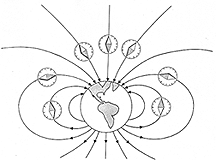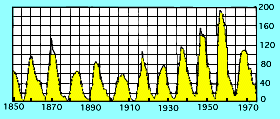Magnetism
Magnetism is familiar to most of us through specially treated iron or some related materials, found in compass needles and used for sticking messages to refrigerator doors, and also used for coating tapes and disks on which music and computer data are recorded. Actually, such "permanent magnets" are a fortunate accident of nature: most magnetism in the universe is not produced in this manner, but by electric currents.
 The magnetism of rare natural "lodestones" was known in ancient Greece--supposedly first noted in the town of Magnesia, from which comes the name. The magnetic compass (a Chinese discovery) was used by Columbus and other early navigators, but it was not until 1820 that a Danish professor, Hans Christian Oersted (pictured on the left), found by accident that an electric current in a wire could deflect a nearby compass needle (click here for the full story). A Frenchman, André-Marie Ampere, showed soon afterwards that the basic magnetic phenomenon was the force between two electric currents in parallel wires; they attracted each other when they flowed in the same direction, and repelled when they were opposed (click here for a more detailed discussion).
The magnetism of rare natural "lodestones" was known in ancient Greece--supposedly first noted in the town of Magnesia, from which comes the name. The magnetic compass (a Chinese discovery) was used by Columbus and other early navigators, but it was not until 1820 that a Danish professor, Hans Christian Oersted (pictured on the left), found by accident that an electric current in a wire could deflect a nearby compass needle (click here for the full story). A Frenchman, André-Marie Ampere, showed soon afterwards that the basic magnetic phenomenon was the force between two electric currents in parallel wires; they attracted each other when they flowed in the same direction, and repelled when they were opposed (click here for a more detailed discussion).
Just as lines of latitude and longitude help us visualize positions on the Earth's globe, so magnetic field lines (originally named by Michael Faraday lines of force) help visualize the distribution of magnetic forces in 3-dimensional space. Imagine a compass needle which can freely turn in space to wherever the magnetic force tries to point it (such needles exist--see bottom of this web page). Magnetic field lines are then imaginary lines which mark the direction in which such a needle would point.

A compass needle, for instance, has two magnetic poles at its ends, of equal strength, the north-seeking (N) pole and the south-seeking (S) pole, named for the directions on Earth to which they tend to point. Suppose the needle is free to point anywhere in 3 dimensions. If placed near the north pole, it would everywhere point towards the pole, and field lines therefore converge there (see drawing). If placed near the south pole, it would point away from it in all directions, and therefore field lines would diverge there, coming out of the Earth in a pattern that is a mirror-image of the pattern at the north pole. In between the lines form big arches above the Earth's equator, with their ends anchored in opposite hemispheres.
Any bar magnet has a pattern of field lines like that of the Earth, suggesting that the Earth acted as if a short but very powerful bar magnet was inside it. Actually such a magnet does not exist, and the pattern comes from electric currents in the Earth core, and slowly changes, year by year; still, the "terrestrial bar magnet" remains a useful visualization aid.
When two bar magnets are brought together, their (N,S) poles attract each other, their (S,S) and (N,N) poles repel: thus if a bar magnet were hidden inside the Earth, its S pole would be the one that pointed northwards, attracting the N pole of the compass needle. This strange mix-up of terminologies often confuses students: it is best to recognize the mix-up exists and then to ignore it.
Michael Faraday who in the early 1800s introduced the concept of magnetic field lines, believed that space in which magnetic forces could be observed was somehow modified. His was a somewhat mystical view, but later mathematical developments found it quite useful, and today we refer to such a region of space as a magnetic field.
The Sunspot Cycle
Sunspots were studied by Scheiner and Galileo in the early 1600s, and then a strange thing happened: for about 70 years (1645-1715) they became a rarity. Some speculate that the unusually cold weather during those years was related to their disappearance, but in any case, by the time they returned, the attention of astronomers had moved elsewhere. It was only in 1843 that a German amateur astronomer, a pharmacist named Heinrich Schwabe (Shwah-bay), noted their most famous feature: their numbers grew and shrank, in a somewhat irregular cycle, lasting about 11 years. For the fuller account of Schwabe's discovery,see here.
